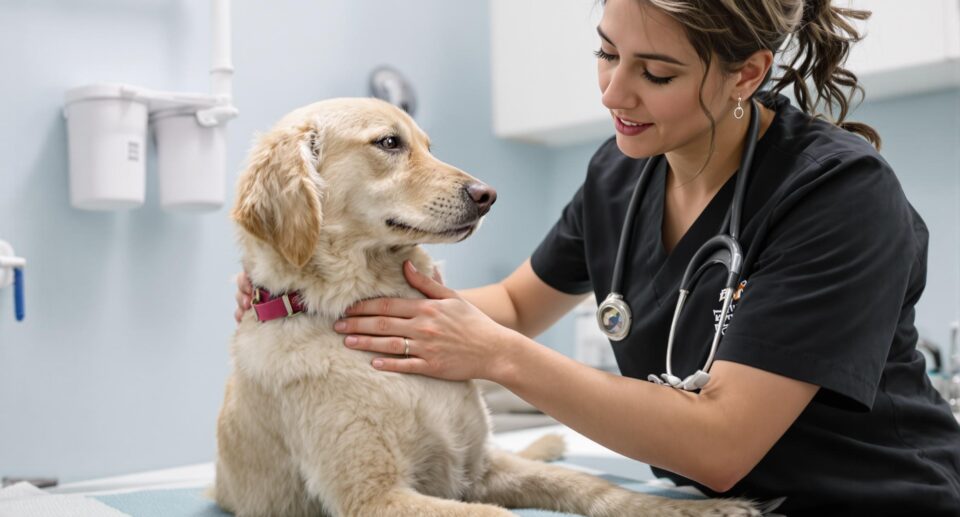Symptoms of Fatty Skin Tumors in Dogs

Dogs with fatty skin tumors (lipomas) have a soft, non-painful swelling in the skin that slowly increases in size. The skin over the fatty tumor remains healthy and covered with hair unless the skin rubs against another part of your dog’s body and is damaged by friction. Skin over a fatty tumor normally does not bleed, does not darken due to increased melanin (hyperpigmentation), or become hot, greasy, or hairless.
Normally, fatty tumors move freely over the muscle and bone beneath them and are not stuck or adhered to underlying tissues. Lymph nodes in the area around a fatty tumor do not increase in size. Appetite, weight, and sleep habits all remain normal. All these signs help differentiate a fatty tumor from a malignant skin tumor.
Fatty tumors usually develop in the skin over the trunk of a dog’s body or legs; they rarely develop on the head, feet, tail, scrotum, or in the perineal area under the tail.
How to diagnose fatty skin tumors in dogs
Diagnosing a lump in your dog’s skin is important because the lump could be an infection—either a fresh abscess or an old walled-off infection called a granuloma, a collection of fluid (cyst, seroma, hematoma), or a tumor, which is another word for cancer.
If the lump is a tumor, there is a 20-30% probability it will be malignant in a dog, and a 50-65% probability it will be malignant in a cat. When a tumor is diagnosed as a lipoma (fatty tumor), it is a great relief, because these are not malignant. About 10% of all dog skin tumors are lipomas. Lipomas rarely occur in cats.
Veterinarians diagnose lipomas in dogs by:
- Feel (palpation)
- needle biopsy
- surgical biopsy or surgical excision.
Tests used for diagnosing fatty tumors (lipomas) in dogs
By feel (palpation) Diagnosing a fatty tumor by feel is an inexact science. Normally, a fatty tumor feels smooth and slides away from underlying tissues, and malignant tumors adhere strongly to underlying muscle and bone. Unfortunately, using palpation as the sole method of diagnosing a mass is unwise. All masses should be definitively diagnosed because the sooner they are dealt with properly, the healthier your pet will be.
Needle biopsy A needle biopsy uses a needle and syringe to pull cells from the mass. The cells are blown from the needle onto a slide, stained, and examined under a microscope.
If the tissue on the slide is from a fatty tumor it will contain fat cells (lipocytes) with an enormous storage area (vacuole) filled with fat. The storage of fat takes up so much room that the cell’s nucleus is pushed over to the side. With a fatty tumor, no infection-fighting white blood cells are found on the slide—unlike the situation with an abscess or granuloma where white blood cells predominate. With a fatty tumor, the nuclei of the fat cells will be inactive—unlike the situation with a malignant tumor, which has active nuclear material.
While most veterinarians can make a preliminary diagnosis from a needle biopsy within a few minutes in the office, it is wise to have a pathologist review all slides. It is also wise to have every lump on your dog biopsied. If every lump is not assessed, it’s easy to develop a false sense of security. A false sense of security is especially common when the lumps are small, but small does not mean innocent.
Although needle biopsies distinguish fatty tumors from infections and from malignant cancers, they cannot distinguish between a fatty tumor and an infiltrative fatty tumor. This distinction requires a surgical biopsy.
Surgical biopsy or excision A surgical biopsy removes a small, but representative sample of tissue, increasing the likelihood the diagnosis will be accurate. A surgical excision removes the entire tissue. Excision (or removal) of fatty tumors is generally not difficult because these tumors slide easily from the skin like a walnut from its shell. Infiltrative fatty tumors adhere to underlying tissue and cannot be completely removed.
Material obtained through surgical biopsy or excision is divided into sections and stored in a preservative such as formaldehyde. The specimen is prepared, usually by freezing, so that it can be sliced into sections that are only a few cell layers thick. Using an electron microscope, a pathologist identifies the type of cells (fat, muscle, bone, skin, etc.) and their nuclear characteristics.





